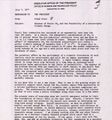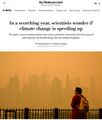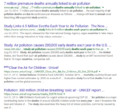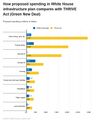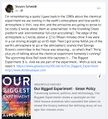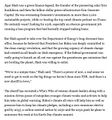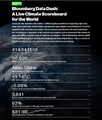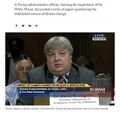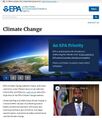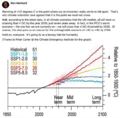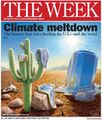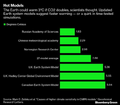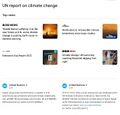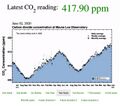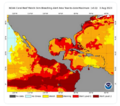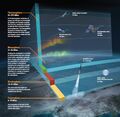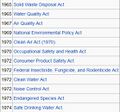Category:Air Quality: Difference between revisions
Siterunner (talk | contribs) No edit summary |
Siterunner (talk | contribs) No edit summary |
||
| Line 39: | Line 39: | ||
''The EPA has studied the effects of the Clean Air Act repeatedly. A first major review came in the 1990s, when researchers found that from 1970 to 1990, cumulative benefits—which include reductions in deaths and illnesses from asthma, heart attacks, and stroke — outweighed costs by an average ranging from $22.2 trillion to $563 billion... it's possible to reduce pollution without crimping economic growth, [http://www.bloomberg.com/news/articles/2016-04-20/can-fresh-air-blow-away-the-case-against-obama-s-climate-policydefying doomsayers' predictions].'' | ''The EPA has studied the effects of the Clean Air Act repeatedly. A first major review came in the 1990s, when researchers found that from 1970 to 1990, cumulative benefits—which include reductions in deaths and illnesses from asthma, heart attacks, and stroke — outweighed costs by an average ranging from $22.2 trillion to $563 billion... it's possible to reduce pollution without crimping economic growth, [http://www.bloomberg.com/news/articles/2016-04-20/can-fresh-air-blow-away-the-case-against-obama-s-climate-policydefying doomsayers' predictions].'' | ||
○ | |||
'''See a snaphshot of the 'modern environmental movement' and first-gen environmental laws''' | |||
:https://www.greenpolicy360.net/w/Environmental_movement | |||
· | · | ||
Revision as of 15:48, 21 December 2016
························································································································
A Story of an Engineering Congressman from Smoggy Los Angeles
SJS / Siterunner: Years ago the smog in LA was so thick and so persistant that the city was regarded as one of the worst cases of air pollution in the world. Out of that mix of environmental disaster, and damage to a generation of kids whose lungs were affected, came the beginnings of the modern environmental movement. Los Angeles and California were at the forefront of the first set of environmental laws, incl air quality. George E Brown, a mentor and friend for over 30 yrs, was a drafter of the original EPA legis and many other key initiatives that are now at the center of green politics. George would have had strong opinions about the latest moves in Congress to roll back the EPA...
································································································································································
See "Air Pollution" -- https://www.greenpolicy360.net/w/Category:Air_Pollution
(In the US) economic health and public health haven't been locked in a zero-sum battle. The air is indisputably cleaner today, even after decades of economic growth. As the Obama administration tries to apply the Clean Air Act to a new environmental problem — climate change — it's worth wondering if past performance ever guarantees future results.
An annual report on air quality from the American Lung Association includes a revealing chart that tracks the percentage change in air pollution, gross domestic product, vehicle-miles traveled, population, energy consumption, and carbon dioxide emissions since 1970, when President Richard Nixon signed the Clean Air Act into law.
https://assets.bwbx.io/images/i7QZmZEjTodU/v1/-1x-1.png
The question before the world is whether we can send climate-warming pollutants in the same direction while unlinking carbon emissions from economic growth. At the heart of the economic argument against Obama's Clean Power Plan, which uses the EPA's authority to phase out the most polluting coal plants, is that we just can't afford it. An analysis commissioned by America's Power, a group representing the coal industry, predicts that Obama's plan would cause electricity prices to spike by double digits and could cost the economy up to $39 billion a year.
"I’ve doing this over 25 years," said Paul Billings, senior vice president of advocacy for the American Lung Association. "I’ve heard this from industry every single time EPA has tried to tighten a standard."
Early evidence from carbon-cutting programs suggests that economies are not left in ruins. Nine northeastern states would have produced 24 percent more emissions if they hadn't formed the Regional Greenhouse Gas Initiative in 2009. From 2009 to 2014, their combined GDP grew by about 8 percent. British Columbia enacted a carbon tax in 2008. Emissions per capita fell 12.9 percent below its pre-tax years—3.5 times larger than the overall decline in Canadian per capita emissions—and the province has not become an economic basket case.
The EPA has studied the effects of the Clean Air Act repeatedly. A first major review came in the 1990s, when researchers found that from 1970 to 1990, cumulative benefits—which include reductions in deaths and illnesses from asthma, heart attacks, and stroke — outweighed costs by an average ranging from $22.2 trillion to $563 billion... it's possible to reduce pollution without crimping economic growth, doomsayers' predictions.
○
See a snaphshot of the 'modern environmental movement' and first-gen environmental laws
·
Subcategories
This category has the following 11 subcategories, out of 11 total.
A
B
C
E
G
P
T
U
Pages in category "Air Quality"
The following 52 pages are in this category, out of 52 total.
C
E
- Each of us can make a positive difference
- Earth Science
- EBikes 360
- Energy Storage - Batteries and Grid
- Environmental agreements
- Environmental full-cost accounting
- Environmental protection
- Environmental Protection Agency
- ESA Living Planet Announcement - May 2022
- European Union Green Deal - Fit for 55
- EV Corridors Electric Vehicles Zero Emission Vehicles
G
- George E. Brown Jr
- Glasgow Climate Summit - Pledges, Promises, Declarations - What's Next Up
- Going Green
- Google Earth Timelapse
- Green Best Practices
- Green New Deal
- Green Stories of the Day
- Green Stories of the Day - GreenPolicy360 Archive
- GreenPolicy360 Archive Highlights 2013
- GreenPolicy360 Archive Highlights 2014
- GreenPolicy360 Archive Highlights 2015
- GreenPolicy360 Archive Highlights 2016
- GreenPolicy360 Archive Highlights 2017
- GreenPolicy360 Archive Highlights 2018
- GreenPolicy360 Archive Highlights 2019
- GreenPolicy360 Archive Highlights 2020
- GreenPolicy360 Archive Highlights 2023
S
Media in category "Air Quality"
The following 200 files are in this category, out of 476 total.
(previous page) (next page)- 1977 from the Office of Science and Technology Policy.jpg 661 × 711; 177 KB
- 2020 record temperatures.png 800 × 502; 358 KB
- 7-20-2020 GreenPolicy360 RT No.2.jpg 591 × 510; 125 KB
- A scorching year, what about the 360 warming data.jpg 600 × 706; 106 KB
- Acceptance on behalf of the United States of America.png 448 × 306; 62 KB
- Act now for a livable future.png 501 × 275; 272 KB
- Ag production and GHG emissions.jpg 680 × 510; 33 KB
- Air Pollution - Air Quality Nov 4, 2019 Delhi.jpg 800 × 469; 92 KB
- Air Pollution Kills, Injures, Cripples, Disables.jpg 600 × 697; 153 KB
- Air pollution moves globally.png 620 × 412; 256 KB
- Air Pollution studies of premature annual deaths.png 634 × 592; 132 KB
- Air pollution, reductions and growth - US 1970-14.png 800 × 450; 198 KB
- American Jobs Act compared w THRIVE Act (Green New Deal).jpg 674 × 798; 90 KB
- Andrew Wheeler - EPA chief-coal industry lobbyist.jpg 640 × 352; 33 KB
- Andrew Wheeler confirmed to head EPA.jpg 753 × 600; 85 KB
- AOC March 26, 2019.jpg 597 × 433; 58 KB
- AOC re climate task force - july 8 2020.jpg 585 × 203; 38 KB
- AskNatureAvatar s.png 200 × 200; 14 KB
- Atmosphere Science.jpg 800 × 600; 45 KB
- Atmospheric Experiment of Humanity.jpg 519 × 574; 201 KB
- Atmotube image.png 620 × 710; 149 KB
- Banking - finance - climate - Mann-1.jpg 452 × 640; 162 KB
- Banking - finance - climate - Mann-2.jpg 452 × 640; 164 KB
- Battle for Democracy.jpg 640 × 123; 24 KB
- Bernie Sanders, Senate 2.PNG 800 × 517; 379 KB
- Bernie Sanders, Senate Aug 3.PNG 800 × 518; 388 KB
- Biden - clean energy ambitions.JPG 640 × 334; 31 KB
- Biden announces EV policies - Aug 2021.jpg 600 × 604; 112 KB
- Biden introduces leadership team - Nov 24 2020.jpg 800 × 644; 173 KB
- Biden re Earth Day 2023.png 640 × 400; 155 KB
- Biden selects Kerry as special climate envoy.jpg 592 × 505; 87 KB
- Biden urged to act - Oct 18 2021 - The Guardian.png 663 × 600; 497 KB
- Biden's assembled an all-star climate team 4-21-2021.jpg 682 × 732; 309 KB
- Biden-Sanders Unity Task Force on Climate.jpg 701 × 780; 139 KB
- Big Oil Rocked by News May 27 2021.jpg 639 × 600; 84 KB
- Big Wobble 2020.jpg 507 × 342; 79 KB
- Biggest climate related legislation in history - 1.png 800 × 188; 68 KB
- Bill Nelson on Global Temp Rise and Climate Change.png 640 × 353; 100 KB
- Bill Nye The Planet's on Fire.jpg 800 × 675; 106 KB
- Biomega-OKO 2.jpg 473 × 360; 34 KB
- Bloomberg Carbon Clock 10-26-2021 8-47-05 AM EST.png 800 × 195; 356 KB
- Bloomberg Live Climate Data Dashboard.jpg 640 × 756; 156 KB
- BMW wireless-charging.gif 640 × 356; 3.19 MB
- Bmw-i3.JPG 800 × 460; 108 KB
- BMW-Solar Charging Point.jpg 537 × 357; 54 KB
- Breakpoint - Reckoning with America's Environmental Crisis.jpg 329 × 500; 49 KB
- Burst of climate denial as Trump presidency ends.jpg 632 × 604; 92 KB
- C40 Cities actions.jpg 1,023 × 696; 174 KB
- California at the forefront of US environmental policies.png 600 × 450; 50 KB
- Car heating and cooling.png 465 × 635; 261 KB
- Carbon Brief - Greenhouse gas levels 2021.png 640 × 436; 292 KB
- Carl Sagan at the Emerging Issues Forum - 1990.png 360 × 460; 192 KB
- Carl Sagan at the Emerging Issues Forum.png 747 × 600; 600 KB
- Carl Sagan, the atmosphere unifies and connects all of our world.png 360 × 390; 229 KB
- Caroline Lucas-Green New Deal.jpg 584 × 391; 71 KB
- CASM Citizen Sci Air Monitor EPA.jpg 300 × 225; 59 KB
- CFSV2 world temp July 3, 2023.png 600 × 800; 513 KB
- CH4 graph - 1980-2020.JPG 640 × 446; 22 KB
- Challenge of Acting for the Commons.png 700 × 548; 175 KB
- Changes in carbon dioxide per 1000 years - via Climate Central.jpg 682 × 424; 34 KB
- Children w masks-air pollution.jpg 620 × 372; 35 KB
- Chile's electric bus fleet.jpg 543 × 541; 74 KB
- China air 2005 2014.jpg 720 × 480; 160 KB
- China Record Heat - August 2022.png 800 × 1,343; 812 KB
- Citisense.png 408 × 83; 26 KB
- Citizens Climate Lobby - Save Our Future Act 2021.jpg 518 × 262; 77 KB
- Climate Action 25th conf in Madrid.jpg 680 × 510; 22 KB
- Climate action isn't 'bunny hugging' says Boris.jpg 800 × 264; 95 KB
- Climate activist - Steven Schmidt - 1978 on.png 600 × 480; 174 KB
- Climate Books - 2020.jpg 800 × 450; 69 KB
- Climate cases on the rise - Nature, Sept 2021.png 800 × 562; 181 KB
- Climate Change COP27 - Nov 11 2022 US Representatives.jpg 712 × 444; 54 KB
- Climate Change COP27 - Nov 11 Kathy Castor.jpg 712 × 710; 77 KB
- Climate Change Laws - database collaboration.png 640 × 271; 76 KB
- Climate Change Laws of the World - database.PNG 768 × 845; 383 KB
- Climate Change Litigation Databases Climate Law.png 800 × 330; 73 KB
- Climate Change US EPA.jpg 600 × 703; 95 KB
- Climate Conferences 1979-2020.jpg 768 × 768; 121 KB
- Climate Crisis - Emily Atkin Heated No. 1.jpg 537 × 453; 61 KB
- Climate Crisis and the Global Green New Deal.jpg 293 × 418; 33 KB
- Climate debate.jpg 493 × 580; 129 KB
- Climate Desk.jpg 390 × 226; 21 KB
- Climate Emergency Institute - Oct 2022.png 610 × 600; 274 KB
- Climate Emergency Institute -- 2021.jpg 800 × 450; 55 KB
- Climate emergency.jpg 800 × 450; 69 KB
- Climate Headline News around the World - July 2023.jpg 600 × 704; 151 KB
- Climate Models.png 639 × 558; 123 KB
- Climate News - Oct 28 2022.jpg 626 × 600; 88 KB
- Climate News - United Nations Report - Feb 2022.png 768 × 878; 539 KB
- Climate News Dec 4 2023 in Dubai.png 800 × 1,037; 649 KB
- Climate Plans Enforcement - Resources - GreenPolicy.png 768 × 897; 686 KB
- Climate poll - Florida.png 640 × 267; 36 KB
- Climate strike - Week 171.png 739 × 600; 834 KB
- Climate Strike Around the World - Sep20,2019.jpg 700 × 830; 119 KB
- Climate Summit - Leonardo DiCaprio.png 600 × 663; 521 KB
- Climate Summit live updates - Nov 2 2021.png 751 × 600; 420 KB
- Climate Summit planned-1.jpg 800 × 301; 53 KB
- Climate Summit planned-2.jpg 800 × 187; 31 KB
- Climate Summit planned-3.jpg 800 × 278; 44 KB
- Climate Summit planned-4.jpg 800 × 241; 41 KB
- Climate usa 60 years on.jpg 800 × 480; 34 KB
- ClimateNewsFlorida.jpg 448 × 191; 36 KB
- CO2 at Mauna Loa data - June 02, 2020 - 417.90 ppm.jpg 640 × 566; 66 KB
- CO2 cumulative emissions 1850 - 2021 - countries.jpg 640 × 462; 211 KB
- CO2 emissions-around-the-world.png 800 × 595; 123 KB
- CO2 global pathways via IPCC AR6 - how will we respond.jpg 800 × 450; 57 KB
- Commons-concepts permanent culture now s.png 448 × 211; 75 KB
- Commons-concepts permanent culture now.png 830 × 391; 39 KB
- Congressman george.e.brown.gif 235 × 305; 41 KB
- COP26 Climate Summit concludes.jpg 600 × 800; 160 KB
- COP26 concludes - 2.png 648 × 467; 177 KB
- COP26 concludes - 3.png 648 × 713; 416 KB
- COP26 concludes.png 648 × 528; 329 KB
- COP26 in GLASGOW - 31 OCT-12 NOV 2021.jpg 800 × 264; 51 KB
- COP27 'opening speech'.png 640 × 460; 160 KB
- COP28 News - Dec 13 2023.png 800 × 898; 410 KB
- Coral bleaching - August 2023.png 488 × 430; 261 KB
- Coral bleaching - NOAA - August 2023.png 488 × 338; 201 KB
- Covering Climate Now.jpg 493 × 498; 67 KB
- Cradle of Civilization - and climate change.jpg 640 × 360; 70 KB
- Dated record of Earths climate - Science Report Sept 10 2020.jpg 735 × 669; 192 KB
- Defend Our Future 6-1-2020.jpg 585 × 458; 103 KB
- Democratic Climate Plan-Introduced June 2020.jpg 528 × 561; 117 KB
- Democratic National Convention-62 climate speakers.jpg 443 × 407; 57 KB
- Democratic Party pres candidates debate in Miami-June 2019.jpg 800 × 534; 124 KB
- Democratic presidential candidates on the Green New Deal.jpg 800 × 359; 57 KB
- Denying human-caused climate change.jpg 639 × 620; 129 KB
- Diesel-smoke-externalities.jpg 220 × 276; 16 KB
- DJT - US message to world.jpg 800 × 266; 45 KB
- Dove1 image.jpg 420 × 308; 26 KB
- Earth Day 2021 - Climate Summit News-1.jpg 491 × 270; 127 KB
- Earth Day 50 years on.jpg 480 × 548; 107 KB
- Earth mapped.png 800 × 783; 254 KB
- Earth Summit 1992-s.png 336 × 418; 283 KB
- Earth Summit 1992.jpg 600 × 746; 171 KB
- Earth trapping unprecedented amount of heat - NASA.jpg 468 × 373; 56 KB
- Earth-upper-atmosphere-NASA.jpg 800 × 781; 327 KB
- EarthScience Missions via the EOS - 2022.png 800 × 219; 139 KB
- Easy Motion 2016.png 800 × 266; 140 KB
- Easy Motion Evo Eco Lite l.jpg 800 × 600; 117 KB
- EBikes in California.jpg 600 × 423; 43 KB
- Economist.com global capital snapshot as of July 2020.jpg 800 × 477; 119 KB
- EDF satellite - methane tracking.png 600 × 674; 388 KB
- Electric busses-China.png 492 × 569; 277 KB
- Electric-vehicle credit Karlis Dambrans-Flickr.jpg 600 × 400; 203 KB
- Elon Musk quote - gas externality price.png 680 × 320; 199 KB
- Elon-musk-tesla-model 3.jpg 705 × 397; 32 KB
- Elon.jpg 300 × 168; 10 KB
- Energy - Electric Measuring and Monitoring.png 715 × 1,978; 862 KB
- Energy Charter Treaty.jpg 512 × 480; 74 KB
- Env policy laws US 'the beginning' of env era.jpg 370 × 345; 65 KB
- Environmental Justice and Environmental Law.jpg 274 × 668; 108 KB
- Environmental laws in US - Supreme Court votes soon.png 800 × 414; 334 KB
- Environmental Protection Agency logo.png 380 × 414; 39 KB
- EPA and the Green Bank - Feb 2023.png 476 × 542; 244 KB
- EPA History Xin Liu-2010.pdf ; 2.88 MB
- EPA website a 'ghost page' now.png 667 × 233; 45 KB
- ERoadArlanda.png 800 × 495; 539 KB
- ESA Living Planet Symposium - Announcement.png 637 × 600; 508 KB
- ESA Living Planet Symposium - May 2022.png 700 × 600; 258 KB
- ESG Fight - Feb 2023.png 396 × 194; 88 KB
- EU agrees to cut emissions 55 percent by 2030.jpg 800 × 558; 96 KB
- EU unveils new climate change policy - July 14 2021 - 1.jpg 800 × 234; 33 KB
- EU unveils new climate change policy - July 14 2021 - 2.jpg 800 × 552; 86 KB
- EU unveils new climate change policy - July 14 2021 - 3.jpg 800 × 549; 89 KB
- EU unveils new climate change policy - July 14 2021 - 4.jpg 800 × 550; 92 KB
- EU unveils new climate change policy - July 14 2021 - 5.jpg 800 × 548; 88 KB
- EU unveils new climate change policy - July 14 2021 - 6.jpg 800 × 557; 89 KB
- EU unveils new climate change policy - July 14 2021 - 7.jpg 800 × 553; 92 KB
- EU unveils new climate change policy - July 14 2021 - 8.jpg 800 × 589; 91 KB
- Europe heat wave - July 19 2022 - via Copernicus satellite.png 600 × 639; 704 KB
- EV charging stations news, US circa Feb 2022.jpg 629 × 480; 101 KB
- EV charging stations, US circa Feb 2022.jpg 519 × 480; 78 KB
- Ev charging-station-for-plug-in-electric-cars.jpg 640 × 381; 28 KB
- EV Futures.png 702 × 461; 389 KB
- EV home charger Leviton EVB40-5PT Level 2.jpg 640 × 640; 47 KB
- EV-home charging station Leviton EVR-Green 160 - Leviton EVB-22.jpg 640 × 509; 48 KB
- EVs.png 800 × 595; 339 KB
- ExxonMobil CO2 climatic response study - Graphic 1 - 1982.png 537 × 680; 150 KB
- ExxonMobil CO2 climatic response study - Graphic 2 - 1982.png 537 × 605; 112 KB
- EZ10.png 554 × 201; 170 KB
- Fact Checking organizations at work.jpg 800 × 390; 44 KB
- Facts Count-WaPo Reports-19127 false-misleading claims in 1226 days.jpg 601 × 489; 100 KB
- Flash charging buses Geneva.png 800 × 251; 509 KB
- Ford and Tesla make EV charging deal.jpg 336 × 419; 117 KB
- Fox on Earth Day 2023.jpg 640 × 275; 58 KB
- Frackers dont clean up.jpg 591 × 493; 60 KB
- From 1968 to 1992 -- and the Journey continues....png 572 × 851; 320 KB
- G Earth Outreach.jpg 800 × 412; 44 KB
- Gavin in Glasgow - Nov 10 2021.png 728 × 600; 378 KB
- George Brown 1969-Reflections on US Role in the World.png 700 × 372; 99 KB
- George Brown, Sci Com't.jpg 200 × 200; 7 KB
- GHG forcings 1750-2020.png 531 × 531; 94 KB
- GHG ppt concentrations 1975-2020.jpg 640 × 361; 69 KB

